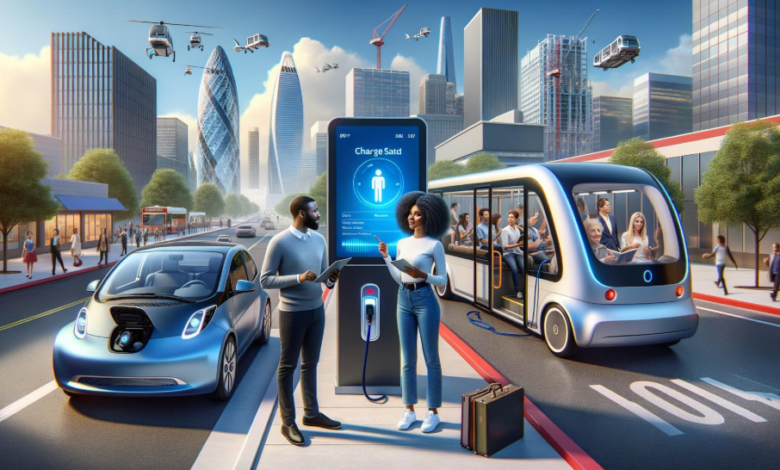How the USA Is Adopting Sustainable Transport with Smart Tech

As the world grapples with climate change and urban congestion, the United States is increasingly turning to sustainable transportation solutions. These solutions aim to reduce environmental impact, enhance mobility, and improve quality of life.
Central to this transformation is the integration of smart technologies that optimize transportation systems. In this article, we explore how the USA is adopting sustainable transport through smart tech, highlighting key initiatives, challenges, and future prospects.
As cities across the country face congestion and rising emissions, the adoption of sustainable transportation solutions in the USA is becoming essential for reducing environmental impact and improving urban mobility
The Need for Sustainable Transportation in the USA
As cities across the USA grow rapidly, transportation systems face increasing pressure to meet the mobility needs of millions of residents. Traditional reliance on fossil-fuel vehicles and outdated infrastructure not only contributes to pollution but also strains urban mobility, leading to congestion and inefficiencies.
Sustainable transportation solutions are becoming essential to balance environmental responsibility, economic efficiency, and the evolving demands of urban populations.
Environmental and Economic Pressures
The transportation sector is a significant contributor to greenhouse gas emissions, accounting for a substantial portion of the nation’s carbon footprint. Additionally, traffic congestion leads to economic losses and decreased productivity. Addressing these issues requires a shift towards more sustainable and efficient transportation systems.
Urbanization and Mobility Challenges
Rapid urbanization has led to increased demand for transportation services. Traditional infrastructure often struggles to meet these demands, resulting in overcrowded public transit and inadequate road networks. Smart technologies offer solutions to enhance the efficiency and effectiveness of urban mobility.
Smart Technologies Driving Sustainable Transport
The adoption of smart technologies is transforming the way the USA approaches sustainable transportation. From intelligent traffic management to connected mobility platforms, these innovations are designed to reduce emissions, optimize energy use, and make transportation systems more efficient and responsive.
By leveraging electric vehicles, autonomous systems, and intelligent transportation networks, is setting the stage for advanced sustainable transportation solutions in the USA that optimize energy use and enhance mobility
By using advanced technologies, cities and companies can create a future where mobility is cleaner, safer, and more sustainable.
Electric and Autonomous Vehicles
Electric vehicles (EVs) are at the forefront of reducing emissions in the transportation sector. The adoption of EVs is supported by advancements in battery technology, government incentives, and expanding charging infrastructure. Autonomous vehicles (AVs) promise to further enhance sustainability by optimizing driving patterns and reducing energy consumption.
Intelligent Transportation Systems (ITS)
ITS involves the use of sensors, cameras, and communication networks to monitor and manage traffic flow. These systems can reduce congestion, improve safety, and lower emissions by providing real-time data to drivers and traffic management centers.
Mobility as a Service (MaaS)
MaaS integrates various transportation services into a single accessible and customer-friendly digital interface. By facilitating seamless connections between different modes of transport, MaaS encourages the use of public transit and shared mobility options, thereby reducing reliance on private vehicles.
See also: Interior Basement Waterproofing Techniques for Long-Lasting Protection
Government Initiatives and Policies
Government action is a critical driver of sustainable transportation in the USA. Policies, incentives, and funding programs at the federal, state, and local levels create the framework for adopting cleaner technologies, expanding public transit, and promoting innovative mobility solutions.
By establishing clear goals and providing resources, government initiatives help accelerate the nation’s transition toward more efficient and environmentally responsible transport systems.
Federal Support for Sustainable Transport
The U.S. government has implemented policies to promote sustainable transportation, including tax incentives for EV purchases and funding for public transit projects. Agencies like the Department of Transportation (DOT) and the Environmental Protection Agency (EPA) play pivotal roles in shaping and enforcing these policies.
State and Local Programs
States and municipalities have launched various programs to support sustainable transport. For example, California’s Zero-Emission Vehicle program sets ambitious targets for EV adoption, while cities like New York and San Francisco invest in bike-sharing systems and pedestrian-friendly infrastructure.
Challenges in Implementing Sustainable Transport
Transitioning to sustainable transportation in the USA comes with its share of challenges. From aging infrastructure to public skepticism and the need for equitable access, implementing new mobility solutions is a complex endeavor.
Understanding these hurdles is essential for policymakers, businesses, and communities to develop strategies that ensure sustainable transport technologies are adopted efficiently and inclusively.
Infrastructure Limitations
The existing transportation infrastructure in many areas is outdated and not designed to accommodate new technologies. Upgrading roads, bridges, and transit systems requires significant investment and planning.
Public Awareness and Acceptance
While awareness of environmental issues is growing, there is still resistance to adopting new transportation technologies. Public education campaigns and incentives are essential to encourage widespread acceptance.
Equity and Accessibility
Ensuring that sustainable transportation options are accessible to all, including underserved communities, is a critical challenge. Policies must address issues of equity to ensure that no one is left behind in the transition to sustainable mobility.
Future Prospects and Innovations
The future of sustainable transportation in the USA is closely tied to innovation and the adoption of forward-thinking technologies. By combining renewable energy, advanced data analytics, and collaborative solutions, transportation systems can become cleaner, smarter, and more efficient.
These innovations promise not only to reduce environmental impact but also to create a more seamless and accessible mobility experience for all.
Integration of Renewable Energy
The future of sustainable transportation lies in integrating renewable energy sources with transportation systems. Solar-powered charging stations and wind energy for public transit are examples of how clean energy can be utilized to power transportation networks.
Data-Driven Decision Making
Advancements in data analytics allow for better planning and management of transportation systems. By analyzing traffic patterns and mobility trends, cities can make informed decisions to improve efficiency and sustainability.
Collaborative Efforts
Collaboration between government agencies, private companies, and communities is essential for the successful implementation of sustainable transportation solutions. Partnerships can lead to innovative solutions and shared resources that benefit all stakeholders.
Conclusion
The adoption of sustainable transportation solutions in the USA is a multifaceted endeavor that involves technological innovation, policy development, and community engagement. By embracing smart technologies and fostering collaboration, the nation can move towards a more sustainable and efficient transportation future.
Continued investment and commitment are necessary to overcome challenges and realize the full potential of sustainable transport.
As the USA continues to develop and implement sustainable transportation solutions, it is crucial to ensure that these advancements are inclusive and equitable, providing benefits to all communities across the nation.





